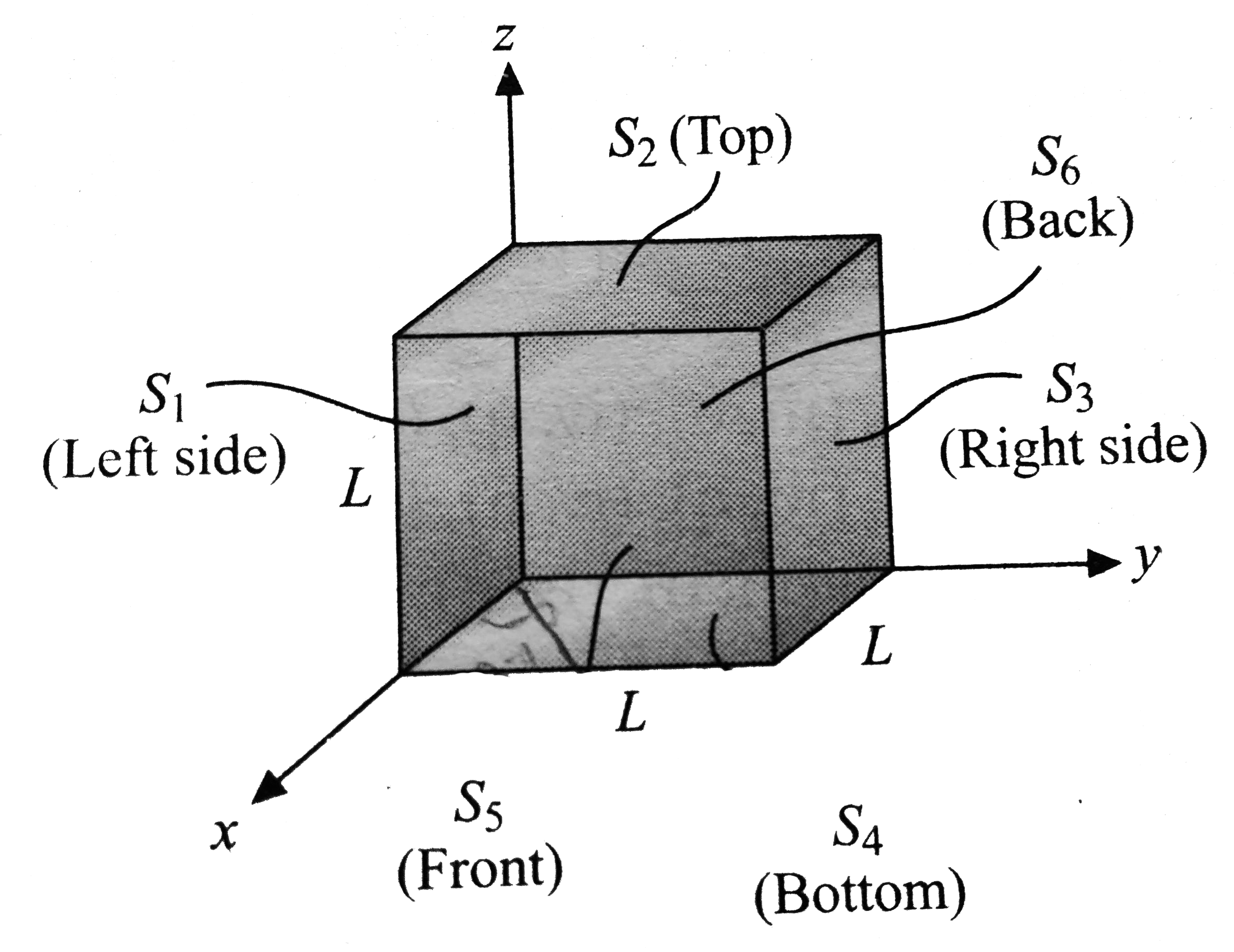The cube shown in Fig. 2.119 has sides of length L=10.0cm . The electric field is uniform , has a magnitude E=4.00×103NC−1 and is parallel to the xy plane at an angle of 37∘ measured from the +x−aξs toward the +y−aξs .

The surface that have zero flux are
S1 and S3
S5 and S6
S2 and S4
S1 and S1
The correct Answer is:C
Phi = vec(E ) . vec(A) = EA cos theta,where,vec(A) = A hat(n)<br>hat(n)_(S_(1) = - hat(j) (left),<br>Phi_(S_1))= -( 4 xx 10^(3) NC^(-1)) (0.1 m)^(2) cos (90^(@) - 37^(@)) = - 24 Nm^(2) C^(-1)<br> hat (n)_(S_(2)) = + hat(k)(⊤),<br>Phi_(S_(2)) = - (4 xx 10^(3) NC^(-1)) (0.1 m)^(2) cos 90^(@)=0
ˆnS3=+ˆj ( right),
ΦS3=+(4×103NC−1)(0.1m)2cos(90∘−37∘)
=+24Nm2C−1
ˆnS4=−ˆk (bottom),
ΦS4=(4×103NC−1)(0.1m)2cos90∘=0
ˆS5=+ˆi (front),
ΦS5=+4(4×103NC−1)(0.1m)2cos37∘=32Nm2C−1
ˆnS6=−ˆi (back),
ΦS6=−(4×103NC−1)(0.1m)2cos37∘=32Nm2C−1
ˆnS6=−(4×103NC−1)(0.1m)2cos37∘=−32Nm2C−1
As the field is uniform , the total flux through the cube must be zero , any flux entering the cube must also leave it.
Topper's Solved these Questions
- BOOK - CENGAGE PHYSICSCHAPTER - ELECTRIC FLUX AND GAUSS LAWEXERCISE - Subjective type7videos
ELECTRIC FLUX AND GAUSS LAW
- BOOK - CENGAGE PHYSICSCHAPTER - ELECTRIC FLUX AND GAUSS LAWEXERCISE - MCQ s38videos
ELECTRIC FLUX AND GAUSS LAW
- BOOK - CENGAGE PHYSICSCHAPTER - ELECTRIC FLUX AND GAUSS LAWEXERCISE - Multiple Correct8videos
ELECTRIC FLUX AND GAUSS LAW
- BOOK - CENGAGE PHYSICSCHAPTER - ELECTRIC CURRENT AND CIRCUITEXERCISE - Interger8videos
ELECTRIC CURRENT AND CIRCUIT
- BOOK - CENGAGE PHYSICSCHAPTER - ELECTRIC POTENTIALEXERCISE - DPP 3.514videos
ELECTRIC POTENTIAL
Similar Questions
The electric field in a region is given by →E=35E0→i+45E0→j with E0=2.0×103NC−1. Find the flux of this field through a recatngular surface of area 0.2m2 parallel to the y-z plane.
View SolutionIn a region where the electric field having magnitude 104NC−1, parallel to Y-axis exists. Calculate the potential difference between two points in that region, A (0, 2m) and B (0, 9m).
View Solution
Knowledge Check
- Question 1 - Select One
The cube shown in Fig. 2.119 has sides of length L=10.0cm . The electric field is uniform , has a magnitude E=4.00×103NC−1 and is parallel to the xy plane at an angle of 37∘ measured from the +x−aξs toward the +y−aξs .

Electric flux passing through surface S1 isA−24Nm2C−1B24Nm2C−1C32Nm2C−1D−32Nm2C−1 - Question 2 - Select One
The cube shown in Fig. 2.119 has sides of length L=10.0cm . The electric field is uniform , has a magnitude E=4.00×103NC−1 and is parallel to the xy plane at an angle of 37∘ measured from the +x−aξs toward the +y−aξs .

Electric flux passing through surface S6 isA−24Nm2C−1B−24Nm2C−1C32Nm2C−1D−32Nm2C−1 - Question 3 - Select One
The cube shown in Fig. 2.119 has sides of length L=10.0cm . The electric field is uniform , has a magnitude E=4.00×103NC−1 and is parallel to the xy plane at an angle of 37∘ measured from the +x−aξs toward the +y−aξs .

The total net electric flux through all faces of the cube isA8Nm2C−1B−8Nm2C−1C24Nm2C−1Dzero
A vertical electric field of magnitude 4.00×105NC−1 just prevents a water droplet of mass 1.000x10−4kgfrom. falling, Find the charge on the droplet.
View SolutionConsider a uniform electric field E=3×103ˆiN/C. (a) What is the flux of this field through a square of 10 cm on a side whose plane is parallel to the yz plane ? (b) What is the flux through the same square if the normal to its plane makes a 60∘ angle with the x-axis ?
View SolutionA uniform electric field E=2×103NC−1 is acting along the positive x-axis. The flux of this field through a square of 10 cm on a side whose plane is parallel to the yz plane is
View SolutionA cube has sides of length L=0.300m. It is placed with one corner at the origin ( refer to Fig.2.119).The electric field is not uniform but is given by →E=(−5.00NC−1)xˆi+(3.00NC−1)zˆk.
The surface that have zero flux areView SolutionAn uniform electric field of magnitude 5×104NC−1 has a dipole of dipole moment 4×10−9cm aligned at 30∘ with the direction of field. Calculate the magnitude of torque acting on the dipole:
View Solution

